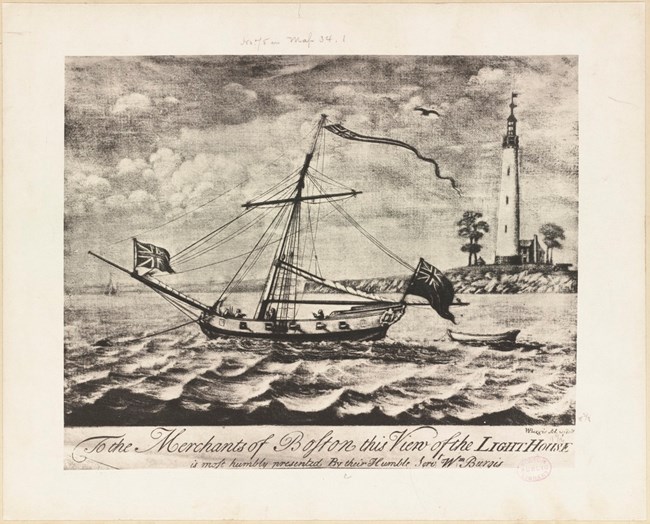SEE BOSTON'S LIGHTHOUSESTake a Lighthouse Cruise
The historic Boston Light overlooks the sea from Little Brewster Island, casting a light beam 27 miles into the Atlantic. This is the oldest continually used lightstation and last staffed lighthouse in the country, which dates back to the Revolutionary War. 
Boston Public Library The structure built by Massachusetts in 1716 was a circular, slightly tapered tower of rubblestone about 60 feet high, with light provided by candles. Also constructed were a keeper’s house, barn, and a wharf. A fog cannon was installed in 1719 (after being discontinued in 1851, it was removed from the island by the Coast Guard in 1962 and returned in 1993). The tower was damaged by fires started by the light in 1720 and, more seriously, in 1751 and by a severe storm in 1723. Each time as well as in 1734–37 the tower was repaired or rebuilt. The most significant damage, however, occurred during the Revolutionary War. On July 20, 1775, when the British occupied Boston and held Boston Light, patriot troops burned the wooden parts of the tower. The British began to repair it, whereupon the Americans burned it again on July 31 and again in September. Finally, in June 1776, as the last of the British were leaving Boston, they blew up the lighthouse.1 Massachusetts did not rebuild Boston Light until 1783. This time it was again circular, constructed of mortared rubblestone, and 75 feet high with the illumination provided by four fish oil lamps. In 1809, when lighthouses were under the purview of the secretary of the treasury, large cracks appeared in the east wall and six iron hoops were then installed around the tower for support (Today there are five, the sixth having been removed sometime between 1917 and 1935. The present aluminum bands replaced corroded steel ones in 1973–74). In 1811 a revolving mechanism was installed to create a flashing light. During the Pleasonton years the condition of the lighthouse apparently deteriorated but improvements were also made—a chandelier with 14 lamps and reflectors was installed in 1828 and the present cast iron stairs, iron window frames, balcony, and large iron door added in 1844. A few years later, the fog cannon was replaced by a wind-up bell in 1851.2 
NPS Photo Under the US Lighthouse Board, many more improvements were made to Boston Light. A second-order revolving Fresnel lens was installed in 1859 and, to accommodate it, the tower was raised to 89 feet. As part of the renovations, the interior of the tower was lined with brick for further support and the brick entry added. In the same year, a frame duplex house was built for the assistant keepers. The fog signals were upgraded a number of times: in 1869 a striking apparatus was introduced, in 1871 a whistle, in 1872 a fog-trumpet, and in 1887 a steam siren. In 1876 a brick building that still stands was constructed to house the fog signal. (It now also houses the generator.) Other buildings constructed in this period and also still standing are the frame keeper’s house and a brick cistern (1884), brick oil house (1889; mineral oil had replaced lard oil as fuel in 1883), and replacement boathouse (1899).3 Under the US Lighthouse Service, the former wick lamps at Boston Light were replaced in 1913 with an incandescent oil vapor (IOV) lamp.4 
NPS Photo/G. Sager More significant changes were made under the Coast Guard. In 1948 Boston Light was electrified. Power was originally supplied by a generator and batteries, replaced in 1957 by an underwater cable from Windmill Point in Hull with generator backup. The motor driving the rotating machinery of the Fresnel lens was also electrified, ending the keeper’s having to wind it by hand every four hours (The keeper still had to climb the stairs to the light at sundown and sunrise every day to turn on and off the switches for the light and the rotating gear). In 1959 Boston Light was changed from a family-operated to a male-billeted station. In 1960 the Coast Guard removed the badly deteriorated duplex assistant keepers’ house by burning it (Since 1990 the cellar of the former duplex has been used for underground fuel storage). Indoor plumbing was finally successfully installed in the keeper’s house in 1960 (Hitherto both the keeper’s house and duplex had outhouses that discharged directly onto the rocks below from where the effluent was washed away by the high tide). In 1964 Boston Light became a National Historic Landmark and in 1987 it was listed on the National Register of Historic Places. In November 1989, just as the Coast Guard was preparing to automate the light and remove personnel from Little Brewster, the US Senate passed a law sponsored by Senator Kennedy requiring that Boston Light be permanently manned. Boston Light thus became the only manned lighthouse in the United States. The law also required that public access to Little Brewster be facilitated, and this occurred during the 1990s, culminating with the official opening of the island to the public in 1999. The light was finally automated in 1998, again the last one in the country, and now remains always “on,” ending the keeper’s having to climb the stairs twice a day. In 2003, Dr. Sally Snowman became the first civilian keeper since 1941 and the first female keeper of Boston Light. After 20 years, Dr. Snowman retired in 2023. Snowman served as the last official lighthouse keeper in the United States.65 Prepared by Nancy S. Seasholes, 2009 The following list is compiled from information in Boston Light: A Historical Perspective by Sally R. Snowman and James G. Thomson.
Footnotes
|
Last updated: September 4, 2025
